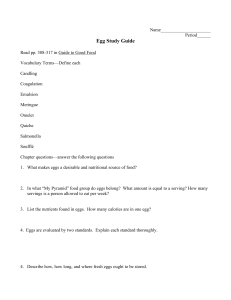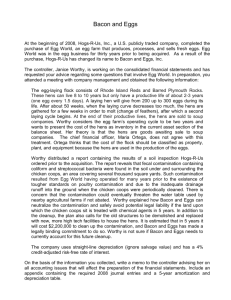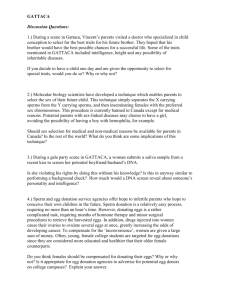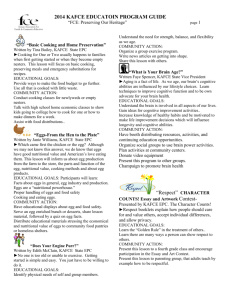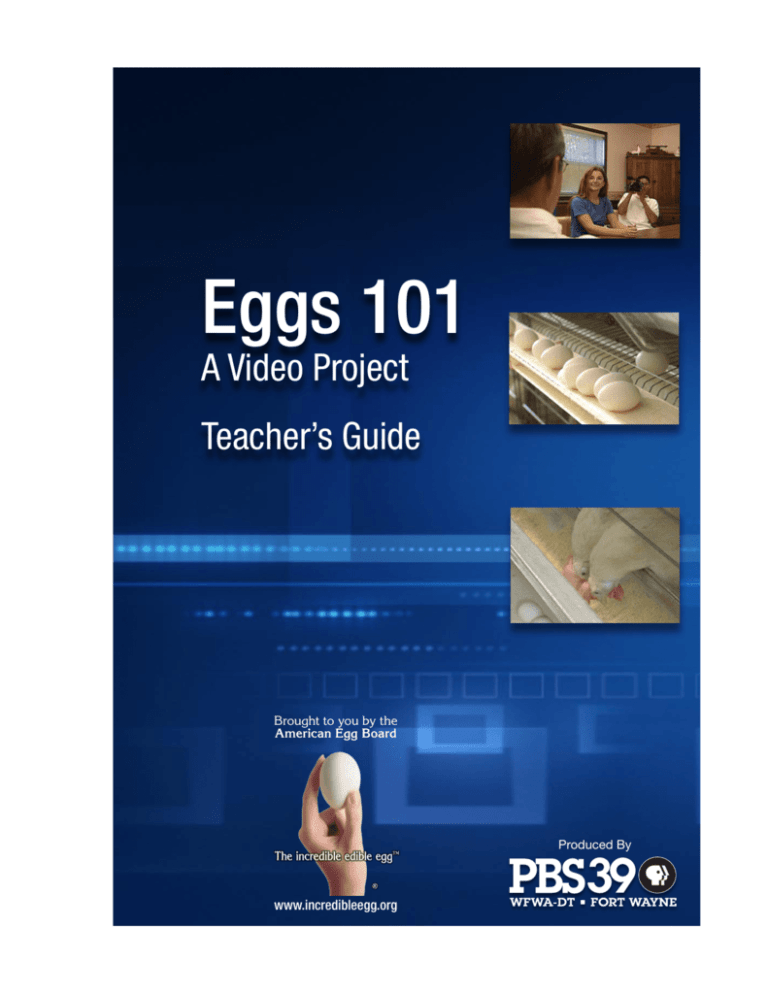
Eggs 101
A Video Project
Teacher’s Guide
Brought to you by the
American Egg Board
Produced By
www.incredibleegg.org
Eggs 101: A Video Project
Video Field Trip Review
Table Of Contents
Chapter 1: The Hen — Quizzes, Answer Keys
Pages 3 - 6
Chapter 2: The Egg — Quizzes, Answer Keys
Pages 7 - 10
Chapter 3: History — Quizzes, Answer Keys
Pages 11 - 14
Additional Information for Chapter 3: History
Pages 15 - 16
Chapter 4/5/6:
Road Trip — Purdue;
Road Trip — Egg Farm;
Hen House — Quiz, Answer Key
Pages 17 - 18
Chapter 5: Road Trip — Egg Farm
How Would You Grade The Egg?
Pages 19 - 20
Chapter 5: Road Trip — Egg Farm —Exercise
Recipe, Extension Questions
Pages 21 - 22
Standards-Based Lesson, Activities
Pages 23 - 27
Applied Economics Lessons, Answer Key
Pages 28 - 31
Bibliography/Internet Links
Page 32
2
Eggs 101: A Video Project — Video Field Trip Review
Chapter 1: The Hen — True or False
Name
Period/Class
Date
1. The most common laying hen is the Rhode Island Red. 2. With commercial hens, their coloring determines the egg color.
3. Brown eggs are preferred in the New England States.
4. Besides color, there is a difference between brown eggs and white eggs. 5. Single-Comb White Leghorns have a much bigger body size
compared to other hens. 6. Disease resistance is a desirable genetic trait. 7. The ovary and the oviduct make up the hen’s reproductive system. 8. Just before laying, the egg turns so it will be laid small end first.
9. The shell membranes are formed in the oviduct. 10. The egg shell is made from calcium carbonate. 3
Eggs 101: A Video Project — Video Field Trip Review
Chapter 1: The Hen — True or False
Answer Key
(Answers in Bold)
1. The most common laying hen is the Rhode Island Red.
False – Single-Comb Leghorn
2. With commercial hens, their coloring determines the egg color.
True
3. Brown eggs are preferred in the New England States.
True
4. Besides color, there is a difference between brown eggs and white eggs.
False – other than color, they are the same.
5. Singe-Comb White Leghorns have a much bigger body size compared to other hens.
False – they have a relatively small body size.
6. Disease resistance is a desirable genetic trait.
True
7. The ovary and the oviduct make up the hen’s reproductive system.
True
8. Just before laying, the egg turns so it will be laid small end first.
False – it will turn large end first.
9. The shell membranes are formed in the oviduct.
False – in the isthmus.
10. The egg shell is made from calcium carbonate.
True
4
Eggs 101: A Video Project — Video Field Trip Review
Chapter 1: The Hen — Fill In The Blank
Name
Period/Class
Date
1. Compared to other hens, Single–Comb White Leghorns reach egg laying maturity
.
2. When raising laying hens, controlled or
3. Hatcheries pick the
breeding is used.
,
birds.
4. The names of original brown egg laying breeds include
and
.
5. If the bird has
feathers and
eggs.
it will lay
6. If the bird has dark
,
lay
,
and
ear lobes, it will
eggs.
7. In the ovary, thousands of future yolks are called
8. Yolks develop in their own sacs called
.
.
9. The dense, shock absorbing layer is called the
10.The egg spends most of its time in the
11.Egg formation takes
about
to
.
.
hours and begins again in
minutes.
5
Eggs 101: A Video Project — Video Field Trip Review
Chapter 1: The Hen — Fill in the Blank Answer Key
(Answers in bold)
1. Compared to other hens, Single–Comb White Leghorns reach egg laying
maturity early.
2. When raising laying hens, controlled or selective breeding is used.
3. Hatcheries pick the strongest healthiest birds.
4. The names of original brown egg laying breeds include Rhode Island Red,
New Hampshire, Plymouth Rock.
5. If the bird has white feathers and ear lobes, it will lay white eggs.
6. If the bird has dark feathers and red ear lobes, it will lay brown eggs.
7. In the ovary, thousands of future yolks are called ova.
8. Yolks develop in their own sacs called follicles.
9. The dense, shock absorbing layer is called the albumen.
10.The egg spends most of its time in the uterus.
11. Egg formation takes 24 to 26 hours and begins again in about 30 minutes.
6
Eggs 101: A Video Project — Video Field Trip Review
Chapter 2: The Egg — True or False
Name
Period/Class
Date
1. Eggs contain the lowest quality protein of all foods. 2. The shell makes up about 50 percent of the total egg weight. 3. The shell of an egg is not solid.
4. The color of the yolk depends on what the hen eats. 5. Grasses are the basis of a hen’s diet. 6. Producers feed all hens exactly the same feed all over the country. 7. The albumen is also called the egg white.
8. The albumen contains just over half of the egg’s protein.
9. As an egg cools, the liquid inside expands. 10.The size of the air cell is used for grading. 7
Eggs 101: A Video Project — Video Field Trip Review
Chapter 2: The Egg — True or False Answer Key
(Answers in bold)
1. Eggs contain the lowest quality protein of all foods.
False – highest quality
2. The shell makes up about 50 percent of the total egg weight.
False – 9% to 12%
3. The shell of an egg is not solid.
True
4. The color of the yolk depends on what the hen eats.
True
5. Grasses are the basis of a hen’s diet.
False - Grains
6. Producers feed all hens exactly the same feed all over the country.
False – Feed type varies across the country.
7. The albumen is also called the egg white.
True
8. The albumen contains just over half of the egg’s protein.
True
9. As an egg cools, the liquid inside expands.
False - contracts
10.The size of the air cell is used for grading.
True
8
Eggs 101: A Video Project — Video Field Trip Review
Chapter 2: The Egg — Fill in the Blank
Name
Period/Class
Date
1. Eggs are popular because they are
no
with
.
2. Eggs come in their own convenient
.
3. The egg shell is made up of
.
4. The tiny pores in the shell allow
and
out and
in.
5. The egg yolk makes up about
6. The
of the liquid weight.
yellow-orange pigment in the hens’ diet
determines the
color.
7. A balanced feed for hens contain
,
.
8. Phosphorus in the feed helps develop strong
9. When laid, an egg is about
10. When cooled, the
and
.
degrees Fahrenheit.
and
membranes
will separate.
9
Eggs 101: A Video Project — Video Field Trip Review
Chapter 2: The Egg — Fill in the Blank Answer Key
(Answers in Bold)
1. Eggs are popular because they are natural with no hormones.
2. Eggs come in their own convenient packaging.
3. The egg shell is made up of calcium carbonate.
4. The tiny pores in the shell allow moisture and carbon dioxide out and air in.
5. The egg yolk makes up about 34% of the liquid weight.
6. The amount of yellow-orange pigment in the hen’s diet determines the yolk color.
7. A balanced feed for hens contain calcium, vitamin D and phosphorus.
8. Phosphorus in the feed helps develop strong egg shells.
9. When laid, an egg is about 105 degrees Fahrenheit.
10.When cooled, the inner and outer membranes will separate.
10
Eggs 101: A Video Project — Video Field Trip Review
Chapter 3: History — True or False
Name
Period/Class
Date
1. Pecking order refers to agressive birds eating all the food before the
other birds can eat it. 2. The term candling came from looking at the egg’s air cell
in front of a candle flame. 3. All eggs are similar in size. 4. World War I brought about many advances in the poultry industry. 5. Refrigeration has little effect on an egg’s freshness. 6. Indoor housing improved egg production by decreasing exposure
to predators and parasites. 7. Raised cage systems allowed for better sanitation and more
uniform feeding in the hen house. 8. Midwest producers modified hen houses by enclosing them
and adding ventilation.
9. Enclosed hen houses led to automation such as conveyors
to handle eggs.
10.Improvements to hen houses not only increased production
but led to healthier birds. 11
Eggs 101: A Video Project — Video Field Trip Review
Chapter 3: History — True and False Answer Key
(Answers in Bold)
1. Pecking order refers to agressive birds eating all the food before the
other birds can eat it.
True
2. The term candling came from looking at the egg’s air cell in front of a candle flame.
True
3. All eggs are similar in size.
False – eggs vary in size, Extra Large, Large and Medium
4. World War I brought about many advances in the poultry industry.
False – World War II
5. Refrigeration has little effect on an egg’s freshness.
False – refrigeration dramatically slows down the egg’s aging process
6. Indoor housing improved egg production by decreasing exposure to
predators and parasites.
True
7. Raised cage systems allowed for better sanitation and more uniform
feeding in the hen house.
True
8. Midwest producers modified hen houses by enclosing them and adding ventilation.
True
9. Enclosed hen houses led to automation such as conveyors to handle eggs.
True
10.Improvements to hen houses not only increased production but led to healthier birds.
True
12
Eggs 101: A Video Project — Video Field Trip Review
Chapter 3: History — Fill in the Blank
Name
Period/Class
1. In the early 1900’s, most egg farms were still
2. Hens living outside encountered two major problems,
Date
systems.
and
.
3.
eggs can have an air cell up to 3/16 of an inch deep.
4. Size is now determined by the
of
a dozen eggs.
5. An egg at room temperature ages
in a
in a day than it does
in a refrigerator.
6. Indoor housing prevented parasites like
.
13
Eggs 101: A Video Project — Video Field Trip Review
Chapter 3: History — Fill in the Blank Answer Key
(Answers in Bold)
1. In the early 1900’s, most egg farms were still backyard systems.
2. Hens living outside encountered two major problems, weather and predators.
3. Grade A eggs can have an air cell up to 3/16 of an inch deep.
4. Size is now determined by the minimum weight of a dozen eggs.
5. An egg at room temperature ages more in a day than it does in
a week in a refrigerator.
6. Indoor housing prevented parasites like leg mites.
14
ADDITIONAL INFORMATION FOR CHAPTER 3
Easy Egg Candler Instructions
1- 60-watt sealed beam flood light bulb
1- ceramic light base
1- lamp cord
1- 4 X 4-inch utility box
1- Romex connector
1- piece of scrap wood for a mounting base
1- cardboard box with a 1 inch diameter hole cut in it
1- roll of black electric tape to secure wires and insulation
Construction of Egg Candler
1. Attach 4 x 4-inch box to scrap wood that is used for a base.
2. Punch out one of the access holes on the utility box and run the lamp cord through
it leaving 4-5 inches of wire inside the box.
3. Using wire strippers, strip the ends of the wire inside the box about 1-quarter (1/4)
of an inch.
4. Tighten connector screws for Romex connector. Make sure lamp cord is secured.
5. Wire lamp cord to the ceramic light base. One wire to the dark screw, one wire
to the silver screw. NOTE: It does not matter which wire goes to which screw.
6. Secure the lamp base to the box using screws provided.
7. Install the flood light bulb into the light base.
8. Cut a small hole, approximately 1 inch in diameter, into the cardboard box. This
hole will be used to concentrate the light.
9. Put the box over the bulb and put an egg over the hole to start candling.
10. Remember safety. Make sure the box is large enough to not come into contact
with bulb. The bulb gets extremely hot. Never leave bulb on and unattended.
Candling Incubated Eggs
Incubated eggs are candled to determine whether they are fertile and, if fertile, to
check the growth and development of the embryo. White eggs should be tested for fertility on the third day. Brown shelled eggs on the fifth or sixth day because it is difficult to
see the embryo clearly before this time.
15
What to look for when candling
A small reddish area with blood vessels extending away from it will be visible in
fertile eggs. This is the embryo floating around inside the egg, looking like a huge red
spider. If the embryo dies, the blood draws away from the embryo and forms what is
called a blood ring. All clear eggs and eggs showing blood rings or streaks should be
removed from the incubator. If eggs are not candled during the early stages of
incubation, it will be difficult to determine whether the egg was fertile; embryos that die
early soon decompose and are not easily distinguished from rotten eggs.
Biology Standard:
B1.15.
Understand and explain that, in biological systems, structure and function
must be considered together.
B.1.31.
Describe how natural selection provides the following mechanism for
evolution: Some variation in heritable characteristics exists within every species
and some of these characteristics give individuals an advantage over others in
surviving and reproducing. Understand that the advantaged offspring, in turn, are
more likely than others to survive and reproduce. Also understand that the
proportion of individuals in the population that have advantageous characteristics
will increase
16
Eggs 101: A Video Project — Video Field Trip Review
Chapter 4: Road Trip — Purdue
Chapter 5: Road Trip — Egg Farm
Chapter 6: Hen House
Name
Period/Class
Date
True or False:
1. Science has become a crucial part of egg production. 2. Hen health and social interaction are two areas of continuing
scientific research.
3. Most egg farms in the U.S. have over 1 million hens.
4. Creighton Brothers Farms was one of the last large egg production
companies to change to a cage system. 5. Today’s egg producers are not concerned with bio-security. Fill in the Blank:
6. Chickens will not lay eggs in the
.
7. There is approximately
United States.
egg laying hen for every person in the
8. Hen houses use a
chicken to the processing facility.
system to send eggs directly from the
9.
refers to keeping pests and diseases away from the flock.
10.
control the feeding as well as the climate in many of the
large egg production houses.
17
Eggs 101: A Video Project — Video Field Trip Review
Chapter 4: Road Trip — Purdue
Chapter 5: Road Trip — Egg Farm
Chapter 6: Hen House
True or False:
Quiz — Answer Key
(Answers in Bold)
1. Science has become a crucial part of egg production.
True
2.
3.
Hen health and social interaction are two areas of continuing
scientific research.
True — Hen behavior in social group situations is an important part of
animal science research.
Most egg farms in the U.S. have over 1 million hens.
False — Of the several hundred egg farms in the U.S., only around 65 have
flocks of 1 million or more laying hens.
4. Creighton Brothers Farms was one of the last large egg production companies
to change to a cage system.
True
5. Today’s egg producers are not concerned with bio-security.
False: Today’s egg producers are very concerned with bio-security and
the health of their animals.
Fill in the Blank:
6. Chickens will not lay eggs in the dark.
7. There is approximately 1 (one) egg laying hen for every person in the United States.
8. Hen houses use a conveyor system to send eggs directly from the chicken
to the processing facility.
9. Bio-Security refers to keeping pests and diseases away from the flock.
10. Computers control the feeding as well as the climate in many of the large
egg production houses.
18
Eggs 101: A Video Project — Video Field Trip Review
CHAPTER 5: Road Trip — Egg Farm
Exercise: How would YOU grade the Egg?
Eggs are graded for their quality. Look at each of the egg samples below and grade them
based upon their characteristics. The chart below will assist you in grading your eggs.
Grade AA
Description
Stands up tall
Yolk is firm
Area covered by whites is small
A
Yolk is round and tall
Whites are flatter than AA
B
Egg spreads more
Yolk is flat
GRADE
GRADE
GRADE
The grade of eggs can change if eggs are not stored correctly or if eggs are kept for
a long time in the refrigerator.
19
Eggs 101: A Video Project — Video Field Trip Review
CHAPTER 5: Road Trip — Egg Farm
Exercise: How would YOU grade the Egg?
Answer Key
Eggs are graded for their quality. Look at each of the egg samples below and grade them
based upon their characteristics. The chart below will assist you in grading your eggs.
Grade AA
Description
Stands up tall
Yolk is firm
Area covered by whites is small
A
Yolk is round and tall
Whites are flatter than AA
B
Egg spreads more
Yolk is flat
GRADE
A
GRADE
B
GRADE
AA
The grade of eggs can change if eggs are not stored correctly or if eggs are kept for
a long time in the refrigerator.
20
Eggs 101: A Video Project — Video Field Trip Review
CHAPTER 5: Road Trip — Egg Farm
Exercise: Recipe and Extension Questions
The American Egg Board provides numerous recipes on their website. Here is an
easy way to treat your students to the wonderful world of eggs.
For more recipes, visit www.incredibleegg.org
Bacon & Egg Breakfast Rolls
Try this recipe for a hearty start to the day. Get your Vitamin C by serving with orange
segments or adding tomato slices to the sandwich.
Ingredients Needed:
• 6 uncut Kaiser rolls
• 3 slices bacon
• 1 cup sliced fresh mushrooms
• 1/2 cup chopped onion
• 1/2 cup chopped green pepper
• 6 eggs
• 1/4 cup skim or low-fat milk
• 6 thin slices lean cooked ham
• 6 thin slices reduced-fat Swiss or Muenster cheese
or any cheese you wish to use
Other Materials Needed:
Hot Plate and Oven
Hot Pads
Spatula
Plates, napkins, forks
10-inch non-stick skillet
Bread knife or other serrated knife
Slice tops off rolls about 3/4 inch from top. With a fork, scrape out the insides of
bottom, leaving about 1/2-inch wall all around. Save crumbs for another use. Set rolls
aside.
In 10-inch omelet pan or skillet over medium heat, cook bacon until crisp. Drain well.
Crumble. Pour off and discard fat. Add mushrooms, onions and pepper to pan. Cook until
tender but not brown, about 5 minutes. Stir in drained bacon.
In medium bowl, beat together eggs and milk until blended. Pour into pan over
vegetables. As mixture begins to set, gently draw an inverted pancake turner completely
across bottom and sides of pan, forming large soft curds. Continue until eggs are
thickened and no visible liquid egg remains. Do not stir constantly.
Spoon egg mixture evenly onto hollows of reserved rolls. Top each roll with 1 slice
each of ham and cheese. Broil about 6 inches from heat until cheese is melted, about 3
minutes. Cover with reserved roll tops.
21
Eggs 101: A Video Project — Video Field Trip Review
CHAPTER 5: Road Trip — Egg Farm
Exercise: Recipe — Extension Questions
1. How else are eggs used in this recipe?
2. How do eggs influence the other agricultural commodities in our society?
3. What might happen to other agricultural commodities if there were a sudden decline
in egg production?
4. Create a flow chart describing how each of the major commodities changes from
raw product to useable form in this recipe.
Example: Eggs = washed – weighed – packaged – sold at market.
Academic standards covered:
Economics:
E.2.9
Business Foundations:
BF.2.6.3 & 4; 4.5.1 & 2
Advanced Foods and Nutrition:
AFN.4.1,2,3 & 4
22
Following are standards-based lessons
to use in the application of the
Eggs 101: A Video Project Video Field Trip
to Economics, Agriculture, Business, and Science
•••••
What is Economics?
In today’s economic society, there are several ways to define economics. Each
definition describes a unique system and each system has a specific way of defining the
way goods and services are produced and made available to the consumer. View the
following definitions for economics:
• Economics is the study of scarce resources among competing alternatives.
• Economics is the study of how individuals and nations make choices about how
to use scarce resources to fulfill their wants.
• Economics is the study of how society allocates scarce resources and goods.
• Economics is the study of how to get the most satisfaction for a given amount of money or to spend the least money for a given need or want.
• Economics is the study of how we work together to transform scarce resources
into goods and services to satisfy the most important of our wants, and how we
allocate these items among ourselves.
• Economics is the study of the decisions involved in producing, distributing,
marketing and consuming goods and services in a given area.
• Economics is the study of efficiency to overcome effects of scarcity to satisfy
the wants and needs of consumers.
• Economics is defined as the science of allocating scarce resources, such as land,
labor, capital and management, among different and competing choices and utilizing
them to best satisfy people’s wants.
• Economics is a social structure that studies how producer, consumers and societies decide among alternative uses of scarce resources in production, exchange and
consumption.
23
Class Activity
Read the nine definitions of economics. Referring to the egg industry, choose the
definition that makes the most sense to you and write a paragraph to explain why.
Compare the definitions and explain what they have in common.
Economic Standard:
E.1.1.
Define each of the productive resources (natural, human, capital) and explain why they
are necessary for the production of goods and services.
E.1.2.
Explain how consumers and producers confront the condition of scarcity, by making
choices which involve opportunity, costs and tradeoffs.
E.1.3.
Identify and explain broad economic and social goals, such as freedom, efficiency,
equity, security, growth, price stability, and full employment.
BF 2.4.1
Identify and contrast different economic systems.
BF 2.4.2
Discuss advantages and disadvantages of different types of economic systems.
BF 2.4.3
Describe the economic roles (citizen, worker, consumer) and illustrate how they interact.
BF 2.4.4
Explain how cultural traditions and customs influence economic behavior in societies.
24
What Do You Want?
We all have things that we want, such as a new car, a new CD or a shopping spree.
Then there are things that we need. How do we define what is needed and what is
wanted in our lives?
Class Activity:
List five needs and five wants that you have as an individual. As a class, share these
lists and compile the results. Are your needs and wants in agreement with everyone in
the class? Write a paragraph explaining why people’s needs and wants may be the same
and different.
Now take on the role of an egg producer. What needs and wants are important to
your business? Make a list of five needs and five wants pertinent to your business.
Compare your list with your classmates. Can you defend your lists?
Economic Standard
E.1.2
Explain how consumers and producers confront the condition of scarcity, by making
choices which involve opportunity costs and tradeoffs.
BF 2.1.1
Define and give examples of economic wants and needs.
BF 2.1.2
Identify the resources that are used to satisfy economic wants and needs.
BF 2.1.3
Explain how economic wants and needs are satisfied.
25
How Would YOU Do It?
Have you ever been told, “If you can do it better, then why don’t you?” In economics,
that is the premise for many people taking on the task of starting their own business. If
you do take on that challenge, there are three basic questions you must answer:
• What should be produced and how much of it should be produced?
• How should we produce it?
• Who should get the product and how much of it should they get?
Along with the three basic questions, entrepreneurs must look at other markets in
their areas and decide how to best fit in to their local economy. Can they be competitive
with traditional goods or should they find a niche product to be competitive?
Group Activity:
In small groups, develop a plan to start an egg business. Answer the three basic
economic questions.
Create a company name and logo for your egg business.
Economic Standard:
E.1.7.
Compare and contrast how the various economic systems (traditional, market, command,
mixed) answer the questions: What to produce? How to produce the product? For whom
to produce the product?
BF 2.2.2
Demonstrate understanding of rational economic decision making by explaining the
costs and benefits of alternative choices in a given situation.
26
More Egg-stension Activities
Select and research one of the six economic systems (traditional, capitalism, fascism,
socialism, communism, or mixed economy). Write a short essay defending the economic
system you favor. Include in your essay key strengths and weakness to both the national
economy and the consumer.
Economic Standard:
E.1.7
Compare and contrast how the various economic systems (traditional, market, command,
mixed) answer the questions: What to produce? How to produce the product? For whom
to produce the product?
Compare and contrast the uses of free range production versus cage system production.
How could you market one or the other to promote sales?
Economic Standard:
E.1.9
Use a production possibilities curve to explain the concepts of choice, scarcity,
opportunity cost, tradeoffs, unemployment, productivity, and growth. Give a class presentation of how supply and demand could effect the wholesale and retail price of eggs.
(Note: An example would be “mad cow disease” in beef production.)
Economic Standard:
E.2.1
Define supply and demand.
E.2.2
Identify factors that cause changes in market supply and demand.
Business Foundations:
BF 2.6.1
Describe supply and demand.
• Using the egg industry, identify as many factors of production as possible that were
used in making the product. Classify each factor as a natural resource, human service
(labor), manufacture resource (capital) or management. Share the information you
gathered in a chart for the class to see.
Economic Standard:
E.1.1
Define each of the productive resources (natural, human, capital) and explain why they
are necessary for the production of goods and services.
27
Applied Economics Exercises: Exercise 1
In your egg production facility, you need to purchase a new candling and sorting
machine to more efficiently sort your eggs. A brand new machine will cost you $25,000. You also have an opportunity to purchase a used machine from another facility that will
also meet your needs. The used machine will cost $15,000. Your wholesale price for
eggs is $0.08 per egg. You have been approved for a ten year loan at a 3% annual
percentage rate.
A)What is the total cost of the new machine?
B) What is the total cost of the used machine?
C)How many eggs would you have to produce to cover the cost of the new machine?
D How many eggs would you have to produce to cover the cost of the used machine.
E)Which machine would you choose. Explain your answer.
Economic Standard:
E.2.6
Explain the function of profit in a market economy as an incentive for entrepreneurs to
accept the risks of business failure.
E.2.12
Illustrate how investment in factories, machinery, new technology and the health,
education, and training of people raises productivity and future standards of living.
E.6.8
Formulate a credit plan for purchasing a major item comparing different interest rates.
Integrated Math Standard:
IM.1.2.2
Solve equations and formulas for a specified variable.
Business Foundations:
BF 2.2.2
Demonstrate understanding of rational economic decision-making by explaining the costs
and benefits of alternative choices in a given situation.
BF 2.3.5
Analyze the impact of technology on productivity.
BF 5.2.1
Identify alternative sources for purchases.
BF 5.2.2
Explain and apply different suppliers’ prices in relationship to quality.
BF 5.2.3
Use published consumer resources to collect information for making buying decisions.
BF 5.2.4
Identify and apply the steps in a rational decision-making process in implementing
an effective buying decision.
28
Applied Economics Exercises: Exercise 2
Your production facility is planning to expand. A new hen house is being proposed to
house an additional 1000 laying hens in a cage system. Assume the total space required
for each hen is three square feet. The wholesale price for eggs is $0.08 per egg.
Assume average egg production per hen is 260 eggs per year.
The contractor has quoted a price of $62.00 per square foot to construct the building
which includes plumbing and electrical work. Also assume you need 150 square feet for
office and washroom space as well as 200 square feet for climate control machinery.
A) How many square feet will your building have to be to accommodate
the 1000 laying hens?
B) How much will the new structure cost to build?
C) Given the price and average production, how long would the new hens take to
pay for the new structure?
Economic Standard:
E.2.6
Explain the function of profit in a market economy as an incentive for entrepreneurs to
accept the risks of business failure.
E.2.12
Illustrate how investment in factories, machinery, new technology, and the health,
education, and training of people increases productivity and raises future standards
of living.
Business Foundations:
BF 2.3.5
Analyze the impact of technology on productivity.
29
Applied Economics Exercises: Exercise 3
You are in charge of hiring a new general employee for your egg farm and the starting wage is $22,000 per year. You also pay an additional $2,000 to cover benefits.
A) How many eggs, at $0.07 per egg, would have to be produced to pay
the employee and their benefits?
B) If your hens lay an average of 265 eggs per year per hen, how many hens
would you have to have to pay the employee?
C) How much does the employee make per hour?
Economic Standard:
E.3.11
Describe how the earnings of workers are determined by the market value of the product
produced and workers’ productivity.
30
Applied Economics Answer Key
1. A. Formula I=P r t
I = Interest Paid
P = Principal amount of Loan
r = Interest rate
t = Time in years
a. I = (25,000) (0.03) (10)
b. I = 7,500
c. Total Cost = 25,000 + 7,500 = 32,500
B. Use Same Formula
a. I = (15,000) (.03) (10)
b. I = 4,500
c. Total Cost = 15,000 + 4,500 = 19,500
C. 32,500 / .08 = 406,250 total eggs or 40,625 eggs per year for 10 years.
D. 19,500 / .08 = 243,750 total eggs or 24,375 eggs per year for 10 years.
E. Student answers will vary given their defense of their decision.
2. A. (Number of hens) (Square foot per hen)
a. 1000 * 3 = 3000 square feet of space for the hens
B. 3350 sq. ft. * $62 = $207,700
C. 1000 hens * 260 eggs per year = 260,000 eggs
a. 260,000 * $0.08 = $20,800 per year.
b. $207,700 / $20,800 = Approx. 10 years to pay off structure.
3. Wage is $24,000 total paid by employer.
a. $24,000 / 0.07 = 342,857 eggs per year.
b. 342,857 / 265 = 1294 laying hens to pay employee.
c. $22,000 / 40 hours per week / 52 weeks = $10.57 per hour.
31
For more facts about
egg production and nutrition
around the world:
American Egg Board
www.incredibleegg.org
32
All rights reserved.
© Copyright 2008 American Egg Board
www.incredibleegg.org




